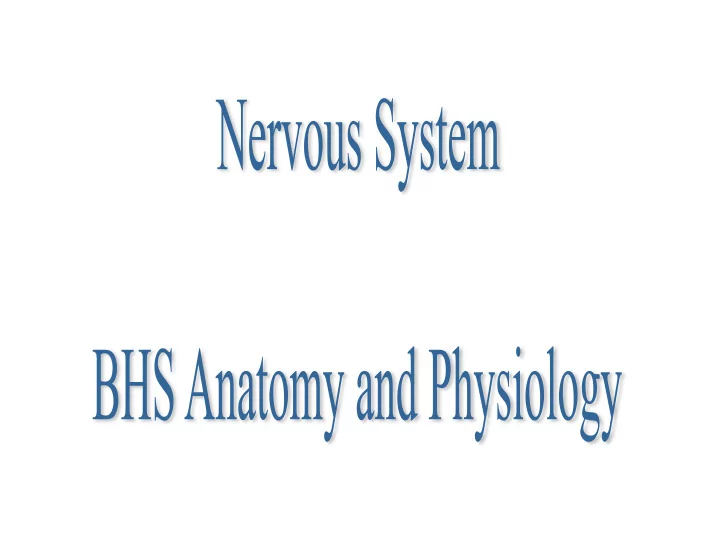

Nervous System I. Two parts A. Central Nervous system 1. Brain 2. Spinal Cord B. Peripheral Nervous system 1. Functions 2. Divisions a. Somatic b. Autonomic 1. Sympathetic 2. Parasympathetic
Central Nervous System: 1. Brain and Spinal cord A. Surrounded by CSF 1. Mechanical protection a. shock absorber b. float B. Chemical protection 1. Assist in nerve transmission C. Circulation 1. Transfer or nutrients and waste from blood to nervous tissues 2. Choroid plexus ~network of capillaries in ventricle walls that form CSF from plasma
2. Tracing (flow of CSF) A. CSF from Choroid Plexus B. Interventricular Foramen C. Increase of CSF from roof of 3rd ventricle D. Cerebral Aqueduct E. 4th ventricle then F. Aperatures 1. One medium 2. Two lateral G. Subarachnoid space H. Posterior surface of the brain and inferior spinal cord I. Reabsorbed into superiorsaggital sinus -appx. 20 ml/hr
Hydrocephalus: “ water head ” -- babies blockage -- adults from injury/illness -trauma -meningitis -subarachnoid hemorrage
3. Brain Blood Supply A. Major supplier 1. Cerebral artery a. Base of the brain b. Circle of Willis 2. Brain is 2% of body weight 3. Brain uses 20 of the Oxygen in a resting adult 4. Glucose used by the brain to make ATP must be constantly supplied as it stores none
5. What gets in: A. glucose, oxygen, Carbon dioxide, water, B. Lipid based substances 1. Caffeine, nicotine, heroin, anesthetics 6. What does not get in: A. Proteins B. Antibiotics
3. Brain Stem A. Medulla Oblongata (Medulla) 1. Inferior part of the brain stem 2. Superior to the foramen magnum 3. Inferior to the inferior pons 4. Contains all ascending and descending tracts 5. Regulates some regions A. Cardio center (rate and force of heart beat) B. Rhythms of breathing C. Swallowing D. Coughing E. Vomitting F. Sneezing G. hiccoughs
4. Pons A. Bridge between the cord and the brain B. Superior to the medulla C. Anterior the cerebellum
Peripheral Nervous System: 1. Neurons (aka Nerve cells) A. Cell body 1. Nucleus 2. Metabolic center of cell B. Dendrite 1. Impulses toward the cell body C. Axon 1. Impulses away from cell body 2. Release neurotransmitters
Motor Neuron
3. Synaptic cleft A. Space between Axon and next dendrite 4. Neurons are covered by lipid based material called Myelin. A. Made up of Schwann cells outside of the CNS. B. Tight wrapping is called the myelin sheath C. Small area outside of the sheath is called the neurilemma D. Gaps or indentations are called Nodes of Ranvier
Multiple Sclerosis (aka MS) autoimmune disorder that attacks the covering of the axon makes impulses less effective can be completely disabling
Recommend
More recommend